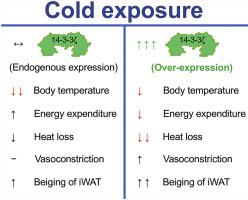Molecular Metabolism ( IF 8.1 ) Pub Date : 2020-07-12 , DOI: 10.1016/j.molmet.2020.101052 Kadidia Diallo 1 , Sylvie Dussault 2 , Christophe Noll 3 , Angel F Lopez 4 , Alain Rivard 1 , André C Carpentier 3 , Gareth E Lim 1

|
Objective
Adaptive thermogenesis, which is partly mediated by sympathetic input on brown adipose tissue (BAT), is a mechanism of heat production that confers protection against prolonged cold exposure. Various endogenous stimuli, for example, norepinephrine and FGF-21, can also promote the conversion of inguinal white adipocytes to beige adipocytes, which may represent a secondary cell type that contributes to adaptive thermogenesis. We previously identified an essential role of the molecular scaffold 14-3-3ζ in adipogenesis, but one of the earliest, identified functions of 14-3-3ζ is its regulatory effects on the activity of tyrosine hydroxylase, the rate-limiting enzyme in the synthesis of norepinephrine. Herein, we examined whether 14-3-3ζ could influence adaptive thermogenesis via actions on BAT activation or the beiging of white adipocytes.
Methods
Transgenic mice over-expressing a TAP-tagged human 14-3-3ζ molecule or heterozygous mice without one allele of Ywhaz, the gene encoding 14-3-3ζ, were used to explore the contribution of 14-3-3ζ to acute (3 h) and prolonged (3 days) cold (4 °C) exposure. Metabolic caging experiments, PET-CT imaging, and laser Doppler imaging were used to determine the effect of 14-3-3ζ over-expression on thermogenic and vasoconstrictive mechanisms in response to cold.
Results
Transgenic over-expression of 14-3-3ζ (TAP) in male mice significantly improved tolerance to acute and prolonged cold. In response to cold, body temperatures in TAP mice did not decrease to the same extent when compared to wildtype (WT) mice, and this was associated with increased UCP1 expression in beige inguinal white tissue (iWAT) and BAT. Of note was the paradoxical finding that cold-induced changes in body temperatures of TAP mice were associated with significantly decreased energy expenditure. The marked improvements in tolerance to prolonged cold were not due to changes in sensitivity to β-adrenergic stimulation or BAT or iWAT oxidative metabolism; instead, over-expression of 14-3-3ζ significantly decreased thermal conductance and heat loss in mice via increased peripheral vasoconstriction.
Conclusions
Despite being associated with elevations in cold-induced UCP1 expression in brown or beige adipocytes, these findings suggest that 14-3-3ζ regulates an alternative, non-thermogenic mechanism via vasoconstriction to minimize heat loss during cold exposure.
中文翻译:

14-3-3ζ 介导雄性小鼠的另一种非产热机制,以减少热量损失并提高耐寒性。
客观的
适应性产热,部分由棕色脂肪组织 (BAT) 的交感神经输入介导,是一种产热机制,可防止长时间暴露在寒冷中。各种内源性刺激物,例如去甲肾上腺素和 FGF-21,也可以促进腹股沟白色脂肪细胞向米色脂肪细胞的转化,这可能代表有助于适应性产热的次级细胞类型。我们之前确定了分子支架 14-3-3ζ 在脂肪生成中的重要作用,但 14-3-3ζ 最早确定的功能之一是它对酪氨酸羟化酶活性的调节作用,酪氨酸羟化酶是脂肪形成中的限速酶。去甲肾上腺素的合成。在本文中,我们检查了 14-3-3ζ 是否可以通过对 BAT 激活或白色脂肪细胞变褐的作用来影响适应性产热。
方法
过度表达 TAP 标记的人类 14-3-3ζ 分子的转基因小鼠或没有Ywhaz等位基因(编码14-3-3ζ的基因)的杂合小鼠被用来探索 14-3-3ζ 对急性(3 h) 和长时间(3 天)寒冷 (4 °C) 暴露。代谢笼罩实验、PET-CT 成像和激光多普勒成像用于确定 14-3-3ζ 过表达对寒冷的产热和血管收缩机制的影响。
结果
14-3-3ζ (TAP) 在雄性小鼠中的转基因过表达显着提高了对急性和长期寒冷的耐受性。与野生型 (WT) 小鼠相比,在应对寒冷时,TAP 小鼠的体温并未下降到相同程度,这与米色腹股沟白色组织 (iWAT) 和 BAT 中 UCP1 表达增加有关。值得注意的是,冷引起的 TAP 小鼠体温变化与能量消耗显着降低有关,这一发现自相矛盾。对长期寒冷的耐受性的显着改善不是由于对 β-肾上腺素能刺激或 BAT 或 iWAT 氧化代谢的敏感性的变化;相反,14-3-3ζ 的过表达通过增加外周血管收缩显着降低了小鼠的热导和热损失。
结论
尽管与棕色或米色脂肪细胞中寒冷诱导的 UCP1 表达升高有关,但这些发现表明 14-3-3ζ 通过血管收缩调节了另一种非产热机制,以最大限度地减少暴露于寒冷环境中的热量损失。


























 京公网安备 11010802027423号
京公网安备 11010802027423号